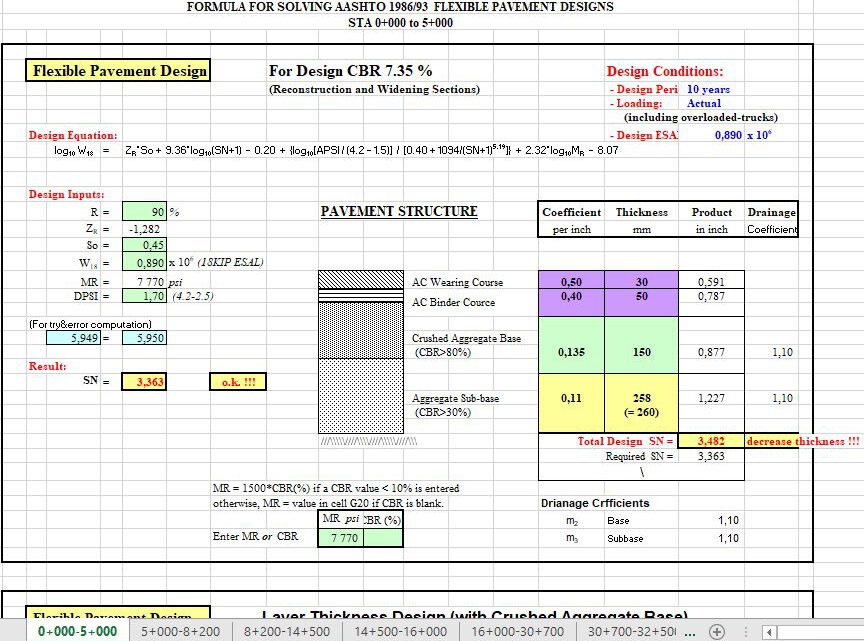
Flexible Pavement Design And Calculation According to AASHTO Spreadsheet
1 February 2025Table of Contents
Flexible Pavement Design And Calculation According to AASHTO Spreadsheet
Flexible pavement is a crucial component of modern road infrastructure, providing durability, adaptability, and cost-effectiveness. Designed to distribute loads efficiently across subgrades, flexible pavements play an essential role in transportation networks worldwide. The American Association of State Highway and Transportation Officials (AASHTO) has established guidelines for designing flexible pavements to ensure optimal performance and longevity. This article delves into flexible pavement design, its components, advantages, and AASHTO design methodology.
What Is Flexible Pavement?
Flexible pavement is a type of road surface designed to withstand traffic loads by flexing and distributing stress over multiple layers. Unlike rigid pavement, which relies on concrete slabs, flexible pavement comprises several layers that work together to enhance performance and durability.
Components of Flexible Pavement
- Surface Course: The topmost layer, usually made of asphalt, provides a smooth driving surface and protects underlying layers from water infiltration and wear.
- Binder Course: A middle layer that enhances load distribution and prevents surface layer deformation.
- Base Course: This layer provides structural support and load distribution, commonly made of crushed stone or asphalt-treated aggregates.
- Subbase Course: Used in high-traffic roads, this optional layer further enhances load-bearing capacity.
- Subgrade: The natural or compacted soil foundation that supports all pavement layers.
Advantages of Flexible Pavement
- Cost-Effective: Lower initial cost compared to rigid pavement.
- Ease of Construction: Can be built in stages and quickly repaired.
- Adaptability: Performs well in various climatic conditions.
- Smooth Ride Quality: Reduces vehicle wear and improves driving comfort.
AASHTO Design Methodology for Flexible Pavement
AASHTO provides a standardized approach to designing flexible pavements, ensuring roads meet structural and functional requirements. The AASHTO pavement design methodology considers various factors to determine the pavement thickness and material selection.
Key Factors in AASHTO Flexible Pavement Design
- Traffic Load (ESALs): The number of equivalent single-axle loads (ESALs) expected over the pavement’s lifespan.
- Subgrade Resilient Modulus (MR): Measures the subgrade’s ability to withstand stress and recover after load applications.
- Design Reliability: The probability that the pavement will perform as intended under specified conditions.
- Serviceability Index: Evaluates pavement condition at different life stages.
- Structural Number (SN): A parameter representing the pavement’s ability to support traffic loads, calculated using layer coefficients and thicknesses.
- Drainage Considerations: Ensures proper water management to prevent pavement deterioration.
AASHTO Pavement Design Equation
The AASHTO 1993 empirical design equation is widely used for flexible pavement design:
log(W18) = ZR × So + 9.36 × log(SN + 1) – 0.20 + log(ΔPSI / (4.2 – ΔPSI)) / (0.40 + (1094 / (SN + 1)^5.19))
Where:
- W18 = Predicted 18-kip equivalent single-axle load repetitions
- ZR = Standard normal deviate for reliability level
- So = Standard deviation
- SN = Structural number of the pavement
- ΔPSI = Difference between initial and terminal serviceability index
This equation helps determine the required pavement thickness based on traffic loads, subgrade conditions, and reliability levels.
Steps in AASHTO Flexible Pavement Design
- Determine Traffic Load: Estimate the expected ESALs over the pavement’s design life.
- Evaluate Subgrade Properties: Conduct soil testing to assess strength and resilience.
- Select Pavement Materials: Choose suitable materials for each layer based on expected performance.
- Calculate Structural Number (SN): Use AASHTO equations to determine the required layer thickness.
- Adjust for Drainage and Climate: Ensure the design incorporates drainage solutions and weather considerations.
- Finalize Pavement Thickness: Confirm the final design based on budget and performance criteria.
Conclusion
Flexible pavement plays an essential role in modern road networks, providing a cost-effective and durable solution for transportation infrastructure. The AASHTO design methodology ensures that flexible pavements meet performance standards, offering reliability, longevity, and efficiency. By understanding and applying AASHTO guidelines, engineers and contractors can design roads that withstand traffic loads and environmental factors while ensuring safety and comfort for road users.
For the best flexible pavement solutions, consult with engineering professionals who specialize in AASHTO-compliant designs. Investing in proper pavement design today ensures long-term benefits in road performance and maintenance costs.








